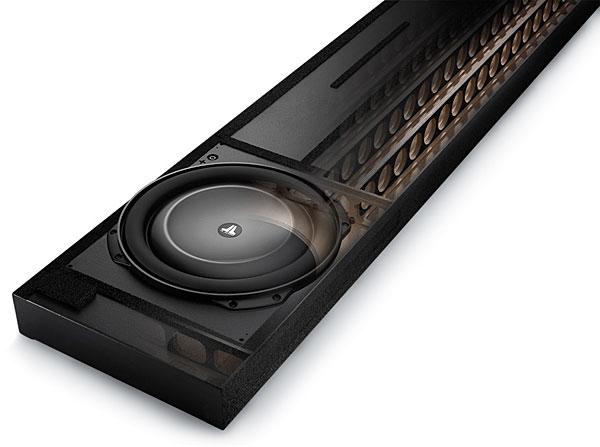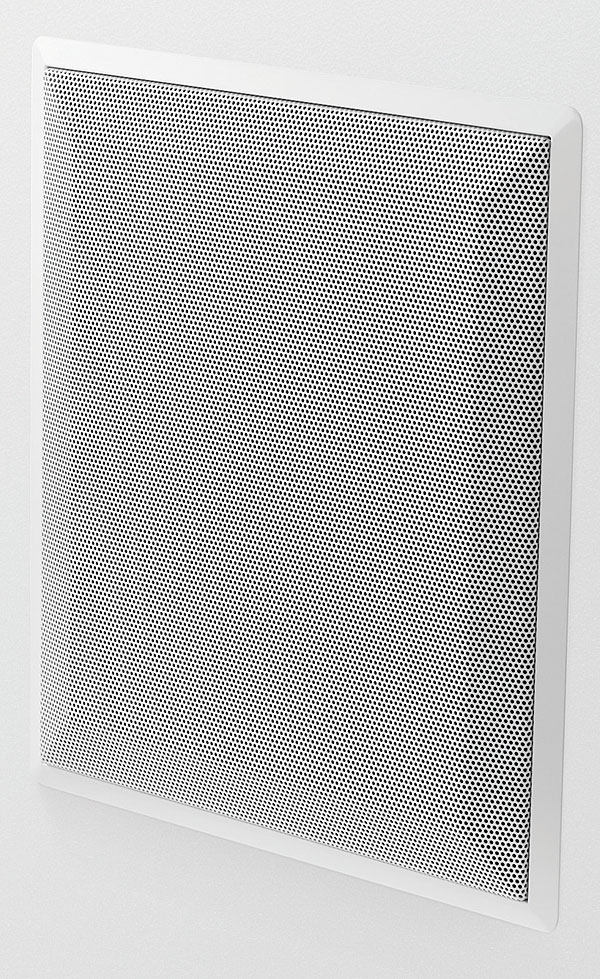subs could be much cheaper and doesn't need much more extra to install one. Depending the number of woofers being used their output could be much more than this from a far smaller amp as well, and it could be calibrated from existing built in tools like Audyssey, etc...
JL Audio Fathom IWS-SYS-1 In-Wall Subwoofer System Review

AT A GLANCE
Plus
Enclosure designed for walls with standard 2 x 4 construction
13.5-inch low-profile driver
1,000-watt external amp with Automatic Room
Optimization
Minus
Retrofit install can be difficult
Expensive
THE VERDICT
This subwoofer system does the seemingly impossible in an impossibly seeming way by hiding an amazingly shallow, high-excursion 13.5-inch woofer, along with the 70-inch-tall cabinet it requires, inside a wall having standard 2 x 4 construction, with only a driver-hiding grille screen as evidence—and it does this surprising feat without causing excessive wall vibrations. Even better, it does all that while performing like a top-end in-room sub.
 If I needed additional proof of how much Rob Sabin, our esteemed editor-in-chief (and part-time male stripper for the visually impaired) dislikes me, this would be it. He asks me the other day if I’d want to review another JL Audio subwoofer, one similar to the company’s ginormous Fathom f212, which I reviewed in 2012. I have fond memories of, bruises from, and a partial hernia caused by that 220-pound behemoth.
If I needed additional proof of how much Rob Sabin, our esteemed editor-in-chief (and part-time male stripper for the visually impaired) dislikes me, this would be it. He asks me the other day if I’d want to review another JL Audio subwoofer, one similar to the company’s ginormous Fathom f212, which I reviewed in 2012. I have fond memories of, bruises from, and a partial hernia caused by that 220-pound behemoth.
Still, without asking my doctor or checking my health insurance, I enthusiastically answer my favorite boss in the affirmative. (It’s the only answer he accepts, so it isn’t much of a stretch.) “Awesome,” he says, breaking in before I’ve gotten to the end of the word yes, “and since you never turn in anything on time, your due date is today. That means you’re already late.” Then, as if it’s barely worth mentioning, he adds, “Oh, by the way, this one’s an in-wall subwoofer. JL says it can be used in new construction or installed in an existing wall. Sounds like just the thing for you.” Without affording me the chance to stutter indignantly or negotiate a higher pay rate, he cuts me off again. “Sorry, buddy, got to go. Doing a show at the nursing home in 30 minutes. Good luck on that in-wall thing.” Click.
To be honest, that’s not exactly how things went down. (I might—might—have made up the part about Rob being a stripper.) But it is true that the logistics of reviewing JL Audio’s Fathom IWS-SYS-1 in-wall powered subwoofer system were dramatically different from those of reviewing the in-room f212. A giant in-room sub gets manhandled into position, and that’s the end of the manual labor. You don’t need a two-wheeled dolly to plop boxes next to a wall for an installation inside the wall. That, however, was just the beginning of the manual labor required for this new Fathom. Fortunately (unless you happen to be the one reviewing the “in-wall thing”), there are professional installers for that.
Double Bass Bonus
Of course, paying a professional to install an in-wall subwoofer costs, well, money (unless you convince your brother-in-law to do the work
in trade for a 24-pack of cheap beer). I can hear your inner frugality whispering, “So, why bother?” Here’s the most obvious answer: to get rid of that ugly, black-box sub taking up floor space in your room. The f212, for instance, is about the size of a large dorm-room refrigerator, making it impossible to disguise. But even smaller subs are hard to conceal or, at the very least, to get out of the way of the “living” aspect of a living room. Unless the gear itself is something you’re extremely passionate about, an in-room sub almost always becomes the acoustic elephant in the room. Nobody likes seeing a sub sitting there; yet nobody says anything because, well, what can you do about it? (Hint: Get an in-wall sub.)

Even if you’re lucky enough to have the perfect hiding spot for an in-room sub, you’ll inevitably encounter Butterworth’s Third Law of Subwoofers: “There is an inverse relationship between the performance of a subwoofer and the convenience of its location in the room.” In other words, find the most livable spot in the room for a sub, and the universe will ensure that the sub will sound its worst at that position. The inverse—the best sound quality will be at the absolutely most inconvenient square footage of floor space—holds true as well. If sound quality is more important to you than hide-ability (which it should be, by the way), here’s a pleasantly surprising fact about in-wall subs: They can skirt Butterworth’s Third Law because nearly all installation locations are convenient. Unless you live in a glass house, have walls covered with large picture frames extending to the floor, or are hemmed in by shelves holding memorial urns with the cremated remains of deceased pets, you’re bound to find a great-sounding spot that’s also totally and very conveniently out of the way.
JL Audi—Who?
JL Audio has been around since the mid-1970s, and the company’s first products were subwoofers for car audio—a market that was (and still is, to some extent) big on boom but small on space. They became known for building high-excursion/small-volume-
enclosure woofers, as well as a line
of custom-fit, car-specific Stealthbox subwoofer systems (and, eventually, marine audio gear). In 2004, the factory began cranking out its first home audio products, the highly impressive Fathom and Gotham in-room subs.
Word is that in 2010, after a long day “evaluating” marine speakers in JL’s special “floating test facility” (wryly named the Bass Boat) off the southern Florida coast, two engineers got into a beer-soaked bet over who could come up with a way of stuffing a Fathom into a wall without the butt-half of the enclosure sticking out into the next room. Or they were attempting to cure Bass Deficiency Syndrome (BDS), which often plagues “spatially challenged” people. (It might have been some other reason, but if so, I don’t remember what they told me.)
It might be a good time for me to point out that JL Audio doesn’t make cheap stuff. (Spoiler alert: possible sticker shock ahead.) The least expensive in-room sub the company currently makes, the Dominion d108-ASH, is $800. That hellaciously awesome Fathom f212 I reviewed sold at the time for $6,300. Its replacement, the Fathom f212v2, is $7,000. And if you want JL’s very best, there’s the Gotham g213v2 for $15,000. Considering that the Fathom IWS in-wall subs are meant to perform as well as their Fathom in-room siblings, it’s not surprising that the prices for the two IWS models are equally stout. For instance, the Fathom IWS-SYS-2—which includes an amp and two in-wall enclosures with a single woofer in each, making it roughly equivalent to the Fathom f212v2—commands a cool $7,500.
Gravity Not Included
For this review, JL Audio sent the Fathom IWS-SYS-1 in-wall subwoofer system,
the single-driver, single-enclosure version, priced at $4,500. The system consists of three main components: a 1,000-watt, 35-pound, “purpose-tuned” amplifier, the woofer enclosure, and
an amazingly shallow—and amazingly heavy—13.5-inch driver. (There’s the grille, too, plus the mounting hardware, but I’ll get to that later.)

The amp’s black-texture-coated top panel, massive heatsinks (on the left and right sides of the chassis), and brushed-aluminum front panel combine to make for a visually stunning piece of hardware—which, sadly or fortunately (depending on your perspective), is likely going to be rack-mounted or stacked on a shelf in an A/V cabinet, to live a life of anonymity. JL says the amp is designed to be “built-in” friendly, and they certainly hit the mark on that count. All of the most-used controls (master level, low-pass frequency, low-pass filter, phase, polarity, and “e.l.f. trim” extreme low frequency) are located on the front panel. Fur- thermore, the amp ships ready to be rack-mounted but includes hardware (rubber feet and rack-ear covers) for placing it on a shelf, where the hefty, side-mounted heatsinks will help keep the amp cool even in a tightly packed stack of gear. And there’s a calibration microphone input with Defeat and Calibrate buttons for JL’s built-in Automatic Room Optimization (A.R.O.). The illumination switch for the LEDs on the front panel offers three positions: off, dim, and on. “Dim,” however, is slightly misleading, because if “off” were 0 and “on” were 10, “dim” would be about 8.7.

The enclosure that JL shipped looked like the monolith from 2001: A Space Odyssey. It was tall (70 inches), thin (2.94 inches), and modest in width (13.75 inches). That’s the perfect size to fit the cavity space between the 2 x 4 (1.5 x 3.5-inch) studs in a normal 16-inch-on-center interior house wall (like mine). Since not all walls are the same, JL offers the IWS-SYS enclosures in various depths for walls with 2 x 4 and 2 x 6 stud variants, to eliminate the need for modifications to the studs. The enclosure is made (in the U.S., by the way) from CNC-cut, cabinet-grade, Baltic birch plywood, and its internal bracing can withstand a magnitude 9.3 earthquake. (That’s just a rough estimate, though.)
In a retrofit installation (like mine), it’s extremely important to inspect the wall cavity and take accurate measurements because of the unique way the sub’s enclosure will reside there. You don’t hurriedly bolt it to the studs and let the sheetrock hide whatever MacGyver-ish modifications you did to hold it in place. The top of this enclo- sure is designed to hang (JL uses the word suspend) from a single anchor point straddling the wall cavity. That means the rest of the enclosure doesn’t rely on anything else to support its weight—not the front or back wallboards, the studs, or even the floor.
- Log in or register to post comments

In the contemporary landscape https://claspo.io/blog/collecting-phone-numbers-7-useful-tips/ , SMS marketing plays a pivotal role in customer engagement and disseminating essential updates. However, given the growing concerns surrounding privacy, it becomes imperative to prioritize transparency and secure customer consent. Recent statistics underscore that 80% of widely-used mobile apps extract data from users' messages, underscoring the necessity of forthrightness regarding data collection practices. The infusion of personalized messages is integral for enhancing engagement and cultivating a positive brand image. By understanding customer preferences, we can craft messages that authentically resonate, demonstrating a genuine concern for their needs beyond mere product sales. The strategic use of popup windows proves effective in gathering phone numbers and directing traffic to your website. However, it is paramount to obtain explicit consent before collecting any data. When employing SMS marketing for deals and offers, exercising moderation is key to sidestepping potential customer apprehensions.





































































